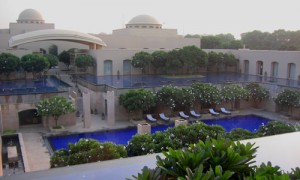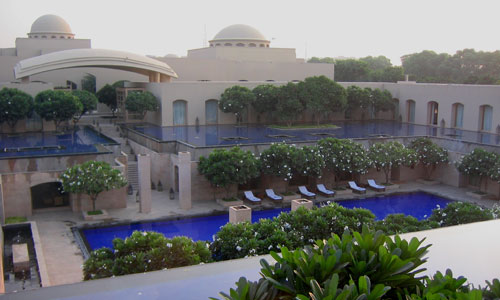 Track2Realty Exclusive: India has traditionally been a reluctant urbaniser and the developers have been even more reluctant to take the roads less travelled. For long it is the government agencies that have been catalyst to land acquisition and hand it over to the developers. Now that the Land Acquisition Bill is set to change the entire ballgame, Track2Realty wonders whether it is time to take a few case studies where a developer has dared to opt for ‘Destination Development’. Though such cases have been few and far between, the road ahead indicates even lesser first movers in the ring.
Track2Realty Exclusive: India has traditionally been a reluctant urbaniser and the developers have been even more reluctant to take the roads less travelled. For long it is the government agencies that have been catalyst to land acquisition and hand it over to the developers. Now that the Land Acquisition Bill is set to change the entire ballgame, Track2Realty wonders whether it is time to take a few case studies where a developer has dared to opt for ‘Destination Development’. Though such cases have been few and far between, the road ahead indicates even lesser first movers in the ring.
Beyond the oft-repeated rhetoric of developers’ ‘location, location & location’ as the USP of the project lies the fact that any prime location has once been a deserted area that the developers were not ready to bet on with the kind of huge investment that realty project demands. It has not just been the case of huge investment with the project but the infrastructure, or rather lack of it made them play safe. Though in some of the cases the government authorities took the initiative to colonise it by providing the necessary infrastructure and auctioned the land to the developers, in some of the cases it was the vision of the first mover who spotted opportunity in a virgin territory.
Interestingly, while it should have been easy urbanisation with the government’s initiative, many of such locations failed to see the emergence of real ‘destination’ that some other location could see. It would be easy to vouchsafe that while the state in most of the cases has been a reluctant urbaniser, the destination development actually demands a dare devil’s vision. That precisely is the reason why only a handful of locations could see the first mover changing the dynamics of urbanisation in general and realty market in particular.
The first such case study in India has been the emergence of Gurgaon at a time when the urban land development was in the controlled regimen of the state. Facing many challenges at the policy level, it was the grand vision of KP Singh, DLF Chairman to replicate a global city in India that Gurgaon was concpetualised ahead of its time.
DLF spokesperson Sanjey Roy says Gurgaon has been initially conceptualised as DLF Qutab Enclave and a grand plan was visualised ahead of its time. It was not an easy job particularly at a time when the urban land development was in the controlled state regime. The success story of Gurgaon eventually led to development of many such destinations across the country. Still, very few locations can match the success of Gurgaon in terms of the holistic living that this micro market provides.
“Of course, one needs to have a vision to transform a non-descript location into a property hotspot. Once it is developed it is much easier to do a cost-benefit analysis and say the location could have been developed this way or that way. When DLF first ventured into Gurgaon, it has been the grand vision of the Chairman, KP Singh that Delhi needs to outgrow its boundaries with the growing urbanisation. Gurgaon, for one was picked up as an extension of what at that point of time was most sought after tourist hot spot, Qutab Minar,” says Roy.
Similarly, in Mumbai it has been the unconventional developers’ vision that could create a destination in far off suburbs such as Powai. Had Hiranandani’s also thought about playing with the land competence of ‘location, location & location’ Powai would not have emerged the way it has shaped up now. Some other locations like Malad and Goregaon, Kalyan-Dombivali are also shaping up as excellent destinations. Interestingly, these destinations were spotted by some of the first mover developers who spotted an opportunity in an area which has for others been roads less travelled.
The Nahar Group has taken up such initiative of developing a new township in Chandivali area. The project titled as ‘Nahar’s Amrit Shakti’ has resulted in creating Chandivali as a destination suburb. The group had begun development in this lesser known area with the vision that in next few years the project would make this location a most preferred destination in Mumbai city. Today, Chandivali suburb competes with other locations such as Powai in residential real estate due to presence of this mega township project in 125 acres.
Nahar Group Vice Chairperson Manju Yagnik agrees that to some extent it is risky to venture in to new destinations with no habitation and infrastructure. Hence, developers undertake some research or study before starting with a new project. Location has its own importance in real estate development but creation of residential projects can also be undertaken by the developer from a futuristic point of view.
“A developer can also create new destination by providing amenities and facilities essential for smooth living. The Nahar Group has the credit of creating Chandivali as a new destination in Mumbai through its mega township project titled ‘Nahar’s Amrit Shakti’. Earlier this suburb was hardly known for residential or commercial development as a major part of this area was a deserted land. The group then undertook development in this area without disturbing the green expanse. Today, the vast 125 acres of land is full of greenery and plush residential towers and commercial complex. The mega township has a shopping complex, school and medical centre. It is a complete township that enables smooth life for every resident. Besides proximity to the domestic and international airport, business districts in Mumbai and arterial roads of Mumbai have made Chandivali a new destination of Mumbai city,” says Yagnik.
Similarly, when the Knight Frank report last year rated South Chennai’s Pallikaranai and Medavakkam as two of the most promising destinations, many within the built environment of realty business were taken aback. Even though Pallikaranai and Medavakkam are about 12 km from the Chennai International Airport through the Pallavaram-Thuraipakkam Road, it was not seen as the destination till some of the developers spotted an opportunity to shift their focus on the region for developing it as the destination.
There are not many case studies in Indian real estate where a developer has shown the dare devil’s attitude with the vision to take the roads/locations less travelled by. The experience suggests that some of them had to take a beating, but for those who could spot the right location to be developed as the destination, it proved to be the goldmine. Isn’t it time that the developers across the country get out of ‘location, location, location’ fixation? Well, for those who want to capitalise on the sheer land competence, established location is all that matters, but for those who do not want to be ‘Me Too’ in the established locations, there are still virgin territories to be explored. Any takers?
Magarpatta City shows the way
The story of developing destinations would still be incomplete without the mention of Magarpatta City, Pune, where the farmers were the developers of a modern destination. Magarpatta City covers 430 acres of land that was owned by about 120 farmer families with 800 individuals.
These farmers joined together to form the Magarpatta Township Development and Construction Company Limited (MTDCCL) and developed the city, thereby realizing their dream of converting their land into a value-added finished product that gave them benefits and returns in perpetuity.
Satish Magar is the de-facto leader of the group because of his educational accomplishments, political connections, largest land holding and the trust that the Magar community has in his leadership and ability to take them to a point where all of them collectively benefit.
Magarpatta City was conceived as an integrated planned township with multiple commercial zones, residential neighbourhoods, school, hospital, shopping malls, hotels, restaurants, and recreation areas. These were designed to be contemporary with futuristic features and included a state-of-the-art IT Park called Cybercity that provided international facilities to leading global IT giants.
Being encompassed by verdant greenery and pollution free environment has added to the townships allure. The city has its own rain water harvesting, garbage segregation and waste management, biogas plant, vermiculture, plant nursery and solar water heating arrangements that creates a self sustainable system and ensures further enhancement of the environment.
A walk to work-home-recreation lifestyle is at the core of Magarpatta. All these facilities came with complete support to run new cutting edge information technology infrastructure, full power back up, ample parking, stringent security, and strict adherence to fire safety norms.





